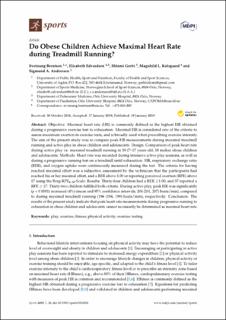| dc.contributor.author | Berntsen, Sveinung | |
| dc.contributor.author | Edvardsen, Elisabeth | |
| dc.contributor.author | Gerbi, Shlomi | |
| dc.contributor.author | Pollestad, Magnhild Louise | |
| dc.contributor.author | Anderssen, Sigmund Alfred | |
| dc.date.accessioned | 2020-03-16T20:13:43Z | |
| dc.date.available | 2020-03-16T20:13:43Z | |
| dc.date.created | 2020-01-31T12:51:08Z | |
| dc.date.issued | 2019 | |
| dc.identifier.citation | Berntsen, S., Edvardsen, E., Gerbi, S., Pollestad, M. L. & Anderssen, S. A. (2019). Do Obese Children Achieve Maximal Heart Rate during Treadmill Running? Sports, 7(1): 26. doi: | en_US |
| dc.identifier.issn | 2075-4663 | |
| dc.identifier.uri | https://hdl.handle.net/11250/2647064 | |
| dc.description.abstract | Objective: Maximal heart rate (HR) is commonly defined as the highest HR obtained during a progressive exercise test to exhaustion. Maximal HR is considered one of the criteria to assess maximum exertion in exercise tests, and is broadly used when prescribing exercise intensity. The aim of the present study was to compare peak HR measurements during maximal treadmill running and active play in obese children and adolescents.
Design: Comparison of peak heart rate during active play vs. maximal treadmill running in 39 (7–17 years old, 18 males) obese children and adolescents.
Methods: Heart rate was recorded during intensive active play sessions, as well as during a progressive running test on a treadmill until exhaustion. HR, respiratory exchange ratio (RER), and oxygen uptake were continuously measured during the test. The criteria for having reached maximal effort was a subjective assessment by the technician that the participants had reached his or her maximal effort, and a RER above 1.00 or reporting perceived exertion (RPE) above 17 using the Borg-RPE6–20-Scale.
Results: Thirty-four children had a RER ≥1.00, and 37 reported a RPE ≥ 17. Thirty-two children fulfilled both criteria. During active play, peak HR was significantly (p < 0.0001) increased (4%) (mean and 95% confidence intervals; 204 (201, 207) beats/min), compared to during maximal treadmill running (196 (194, 199) beats/min), respectively.
Conclusion: The results of the present study indicate that peak heart rate measurements during progressive running to exhaustion in obese children and adolescents cannot necessarily be determined as maximal heart rate. | en_US |
| dc.language.iso | eng | en_US |
| dc.publisher | MDPI AG | en_US |
| dc.rights | Navngivelse 4.0 Internasjonal | * |
| dc.rights.uri | http://creativecommons.org/licenses/by/4.0/deed.no | * |
| dc.title | Do Obese Children Achieve Maximal Heart Rate during Treadmill Running? | en_US |
| dc.type | Peer reviewed | en_US |
| dc.type | Journal article | en_US |
| dc.description.version | publishedVersion | en_US |
| dc.rights.holder | © 2019 The Author(s) | en_US |
| dc.subject.nsi | VDP::Samfunnsvitenskap: 200::Samfunnsvitenskapelige idrettsfag: 330 | en_US |
| dc.source.pagenumber | 7 | en_US |
| dc.source.volume | 7 | en_US |
| dc.source.journal | Sports | en_US |
| dc.source.issue | 1 | en_US |
| dc.identifier.doi | 10.3390/sports7010026 | |
| dc.identifier.cristin | 1788093 | |
| dc.source.articlenumber | 26 | |
| cristin.qualitycode | 1 | |

